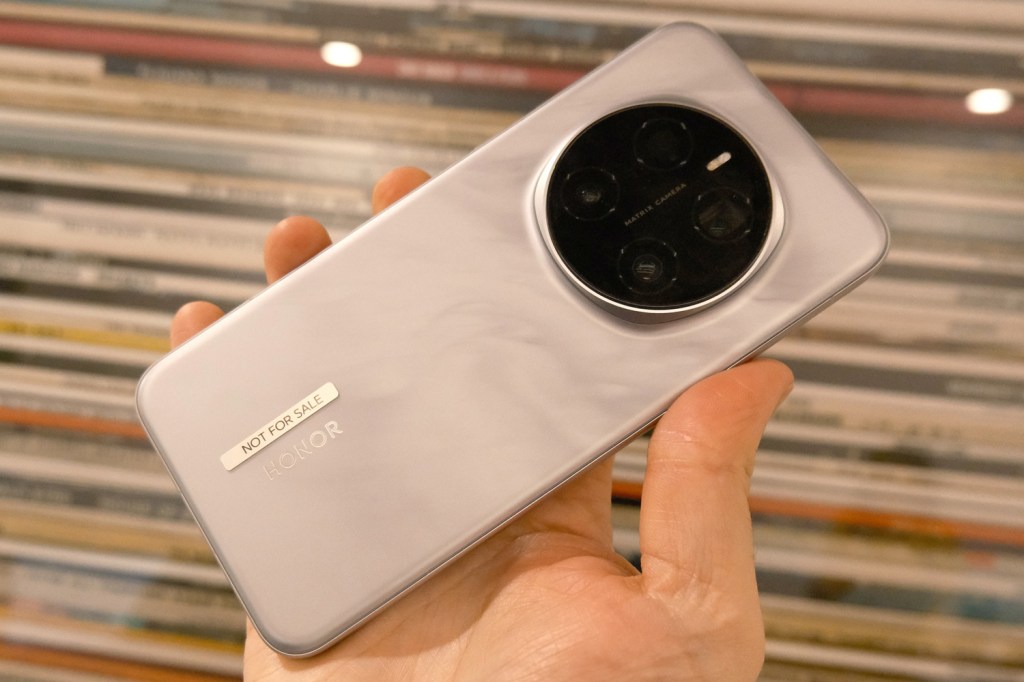It’s the time of year again, when Chinese phone fans get a multi-month head start on the next generation of flagship handsets, and the rest of the world has to sit on its wallet. Xiaomi, OnePlus and Honor all have upcoming smartphones that aren’t quite so upcoming if you live in the East. Are they going to be worth the wait? I recently got some hands-on time with the Chinese market version of the Honor Magic 7 Pro to find out.
The successor to the well-received Honor Magic 6 Pro is officially coming to the UK and Europe in January 2025, with pre-registration open now on the Honor UK website – including £300 of early bird vouchers. Photography is the focus once again, with one of the highest pixel count zoom lenses of any phone and a variable aperture main snapper that should give an the edge in low light.
A big battery, a fresh design that follows current phone world trends, and some of the fastest mobile silicon around only add to the Honor Magic 7 Pro’s appeal – and help it fight the upcoming Samsung Galaxy S25 Ultra.

Honor has been using curved-edge screens on its flagships for what feels like forever, so the Magic 7 Pro’s 2.5D glass and flat metal frame feel like a major design departure. They also have the unfortunate effect of making it look like any number of recent handsets from a bunch of different brands. At least the giant circular camera bump around the back has a unique squircle shape to set it apart from rivals.
I quite liked the glacier white colour of my demo unit, which had a pearl-like look and slightly frosted finish that hid fingerprint marks very well. In China you can also get one in Sunrise gold, breeze blue, lunar shadow grey and black colours, though it’s unclear which will make the grade when it launches in other markets. IP69 water resistance is a new one, on top of the more typical IP68, and means the phone can survive water jets as well as full submersion.
At 6.8in the screen is a pretty typical size for a modern Android flagship, though the pill-shaped selfie camera cutout has more in common with an iPhone. It’s got 3D depth-sensing for secure facial recognition that should play nicely with your banking apps, though I didn’t get to test it during my demo.
The 2800×1280 resolution looked wonderfully sharp, and the OLED panel really popped with colour and contrast. I’ve no idea how close it get to Honor’s claimed 5000 nits peak HDR brightness, but can confirm the 1-120Hz LTPO adaptive refresh rate reacted quickly to my swipes and scrolls.


Really though, it’s the rear cameras that have me most excited about the Honor Magic 7 Pro’s worldwide launch. It carries across the same 50MP lead snapper as its predecessor, meaning you get the same variable f/1.4-f/2.0 aperture for convincing depth blur when you want it and sharper shots when you don’t regardless of lighting conditions. The 50MP ultrawide can double as a macro lens, and Honor’s Eagle Eye image processing should be able to cope with fast-moving subjects.
The 3x optical zoom telephoto should be the standout, with a massive 200MP pixel count and OIS. The sensor size is far bigger than most traditional phone zoom cameras, and cloud-based AI can take over for 30x or stronger magnification, so I’m expecting seriously good things.
The few test shots I took looked clean, detailed and with natural colours, though I wasn’t able to take the files away for further testing. A verdict will need to wait for a full review, where it’ll need to put in a fantastic showing to fend off the simply superb Vivo X200 Pro. I’m very glad to see Honor is bringing the distinctive Studio Harcourt portrait mode from the Honor 200 Pro, too.


My demo session wasn’t long enough to properly test the Honor Magic 7 Pro’s Snapdragon 8 Elite chipset, which comes with either 12 or 16GB of RAM and 256GB, 512GB or 1TB of storage in China. The combo has delivered epic 2D performance in other phones I’ve tested lately, and gaming is top-tier as well, so I don’t doubt this will feel every bit the flagship.
With my unit running the Chinese version of Honor’s Magic UI 9.0 there was no sense digging too deep into its YOYO smart assistant. Many of its abilities, like ordering takeout from a fast food app using your voice, are exclusive to Honor’s home market. The iPhone Dynamic Island-like Magic Capsule was present, though, surrounding the selfie camera pill with useful widgets like music playback.
It’ll be interesting to see how long the 5850mAh battery lasts in typical use; this is smaller than the Vivo X200 Pro’s 6000mAh cell, and the Snapdragon 8 Elite’s efficiency is still relatively unknown (I’ve only tested one phone with it at the time of writing). 100W wired and 80W wireless recharging are near the top of the class, though.


We’ve still got more than a month of waiting (at the time of writing) before the Honor Magic 7 Pro is official outside of China. Based on a brief early look, I think it’s shaping up to be a stunner, with camera hardware that rubs shoulders with the best photography-centric phones. There weren’t any obvious weak links on first inspection, either.
The biggest question mark right now is price. In China the phone starts from 5699 RMB (about £620/$800), but that will most likely double by the time it reaches other countries. With the Oppo Find X8 Pro already on sale for £1099 and the OnePlus 13 expected in a matter of weeks, I’m hoping Honor will stay competitive – especially as the Galaxy S25 Ultra is surely just around the corner as well.










